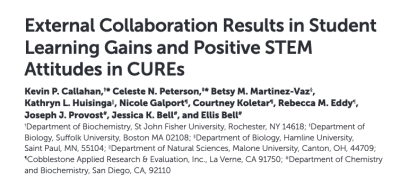External Collaboration Results in Student Learning Gains and Positive STEM Attitudes in CUREs

Callahan, K. P., Peterson, C. N., Martinez-Vaz, B. M., Huisinga, K. L., Galport, N., Koletar, C., ... & Bell, E. (2022). External Collaboration Results in Student Learning Gains and Positive STEM Attitudes in CUREs. CBE—Life Sciences Education, 21(4), ar74. 10.1187/cbe.21-06-0167
Abstract
The implementation of course-based undergraduate research experiences (CUREs) has made it possible to expose large undergraduate populations to research experiences. For these research experiences to be authentic, they should reflect the increasingly collaborative nature of research. While some CUREs have expanded, involving multiple schools across the nation, it is still unclear how a structured extramural collaboration between students and faculty from an outside institution affects student outcomes. In this study, we established three cohorts of students: 1) no-CURE, 2) single-institution CURE (CURE), and 3) external collaborative CURE (ec-CURE), and assessed academic and attitudinal outcomes. ...